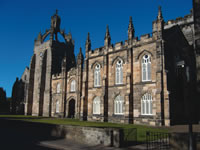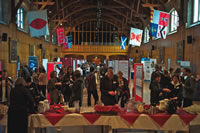|
|
Vol.
34 No. 1
January-February 2012
by Eva M. Krupp and Jörg Feldmann
The fourth International Conference on Trace Elements in Food (TEF-4) took place in the far north of Europe, more precisely in Aberdeen, Scotland from 19–22 June 2011. The conference, which covered a diversity of topics pertaining to the important role that trace elements play in our health and well-being, was held at King’s College Conference Centre in Old Aberdeen, in the heart of Scotland’s third oldest university, founded in 1495. During three days, 150 delegates from 39 countries came together to experience 13 invited lectures, 25 oral presentations, and 108 posters.
 |
Joerg Feldmann opening
the conference. |
Trace elements in our diet are the main source of essential, as well as toxic, elements that wind up in our bodies. Malnutrition due to a lack of essential trace elements like zinc, selenium, iron, or iodine affects millions of people worldwide. While exposures to toxic elements like mercury or arsenic also affects millions of people’s health worldwide.
The idea of TEF is to combine these different aspects of trace elements in diet, and to shed light on their biological action, whether beneficial or toxic, or, as in the case of selenium, their ambivalence. This goal was achieved by bringing together researchers from different disciplines and backgrounds in an interdisciplinary approach.
The scientific program of TEF-4 was subdivided into four larger themes, each theme represented by invited speakers and further oral presentations:
- Source and transfer of trace elements into food and feed
- Trace elements in nutrition and health
- Toxicology and risk assessment of trace elements in food
- Analytical advances in trace elements in food
The conference was opened by Joerg Feldmann, chair of Environmental Analytical Chemistry at the University of Aberdeen and symposium chair.
The first session on the “Source and Transfer of Trace Elements into Food and Feed” was chaired by Andrew Meharg (University of Aberdeen). The first invited speaker, David Salt (formerly of Purdue University, USA, and now at University of Aberdeen), opened the conference with a paper on the ionome of plants and its connection to the genome. He discussed how to unravel the relationship between the genes and their expression in terms of element distribution and concentration in plant cells. The session continued with papers on the uptake of toxic metals in rice, and finished with a second invited speaker, Fangje Zhao (Rothamsted Research Centre, UK), stressing the importance of arsenic and selenium speciation in soil for their uptake in crops.
The second conference theme, “Trace Elements in Nutrition and Human Health” (chaired by John Beattie and Heidi Goenaga-Infante of the UK), was opened by invited speaker Nancy Krebs (USA), reporting on her investigation of zinc and human health through the use of stable isotopes. Two more lectures on zinc followed that covererd biomarkers for zinc status determination and gastro-intestinal uptake. Gender-related differences in iron metabolism and essential elements in chocolate were the topics of two more oral presentations. The next invited speaker, Alan Sneddon (UK), reported on the importance of selenium to human health and its role as an antioxidant agent. Three further oral presentations dealt with selenium and selenium compounds in the diet, with another presentation on the iodine status of the Australian population. This theme was closed by invited speaker Philip White (UK), who stressed the possibility of biofortification of human nutrition with essential elements.
 |
| University of Aberdeen, King’s College. |
The third session on “Toxicology and Risk Assessment of Trace Elements in Food” (chaired by Francesco Cubadda, Italy; Eva Krupp, UK; and Marie Vahter, Spain) featured two invited speakers. Allan Smith (USA) connected arsenic metabolism and exposure with epidemiological risk assessments, while Marie Vahter stressed the importance of early life exposure and its life-long consequences. Two more oral presentations featured arsenic speciation in baby food and the gastro-intestinal tract. The second part of this session featured a variety of elements, starting off with invited speaker Xinbin Feng (China), who reported on methylmercury accumulation in rice grain in mercury-polluted areas of China. The role of manganese toxicity was evaluated by Tanja Schwerdtle (Denmark), which was followed by presentations on cerium, cadmium, and other toxic elements. The third part of this session dealt exclusively with arsenic, featuring invited speaker Beatriz de la Calle (EU) who reported on the importance of reference materials and standardized methods for arsenic determination in food. Four further presentations were given on the importance of arsenic and its determination in food, with a closing talk by Andrew Meharg (UK) on rice as an important source of arsenic.
The fourth theme, “Analytical Advances in Trace elements in Food” (chaired by Ryszard Lobinski, France, and Jens Sloth, DK) was opened by invited speakers Jens Sloth and Enzo Lombi (Australia). Sloth presented novel developments and discussed future needs in trace element analysis for food and feed. Lombi evaluated the usefulness of synchrotron techniques, which can determine element distribution in situ. Three additional oral presentations, featuring imaging, mercury speciation, and metallomics studies followed. Invited speaker Heidi Goenaga-Infante reported on the needs and challenges in the development of reference materials for selenium speciation in food and supplements. Georg Raber discussed pitfalls in arsenic speciation in food followed and the challenge of selenium speciation in a commercial standard. The last talk of the conference was given by invited speaker Ryszard Lobinski, who presented a detailed overview of highly advanced techniques in trace element determination in food stuffs.
IUPAC poster prizes were awarded as follows:
- “Micro-Scale Distribution of Cadmium, Zinc, and Manganese in Rice Node” presented by N. Yamaguchi and co-workers S. Ishikawa, T. Abe, K. Baba, T. Arao, and Y. Terada from the National Institute for Agro-Environmental Sciences and Synchrotron Radiation Research Institute in Japan
- “Hyphenation of RP-HPLC to HR-ICP-MS and Simultaneously to HR-ES-MS for Direct Identification and Quantification of Arsenolipids in Capelin Fishmeal” presented by K. Amayo and co-workers A. Petursdottir, H. Gunnlaugsdottir, C. Newcombe, A. Raab, E. Krupp, and J. Feldmann, University of Aberdeen, Scotland
- “Synthesis, Analysis and Cell Toxicological Characterization of Thio-DMA” presented by M. Bartel and co-workers L. Leffers, U. Karst, F. Ebert, and T. Schwerdtle from University of Muenster, Germany
 |
| Exhibition, poster, and coffee/tea break in Elphinstone Hall. |
The conference was complemented with a social program that included a tour of a Whisky Distillery, a visit to a Scottish Castle (Crathe’s Castle) with its famous walled garden, and a trip to the fishing village of Stonehaven south of Aberdeen. An icebreaker party, held in the evening in the heart of the old King’s College Campus, featured bagpipes, beer, and an optional whisky tasting. Monday night saw a Civic Reception in Cowdry Hall in the commercial center, sponsored by the Aberdeen City Council. On Tuesday night, Elphinstone Hall, often called the “Harry Potter Hall” was the venue for the conference dinner, which closed with a performance by one of the best Ceilidh bands of Scotland, Clachan Yell—everyone was encouraged to join the dance.
www.abdn.ac.uk/tef-4
Page
last modified 6 January 2012.
Copyright © 2003-2012 International Union of Pure and Applied Chemistry.
Questions regarding the website, please contact [email protected] |